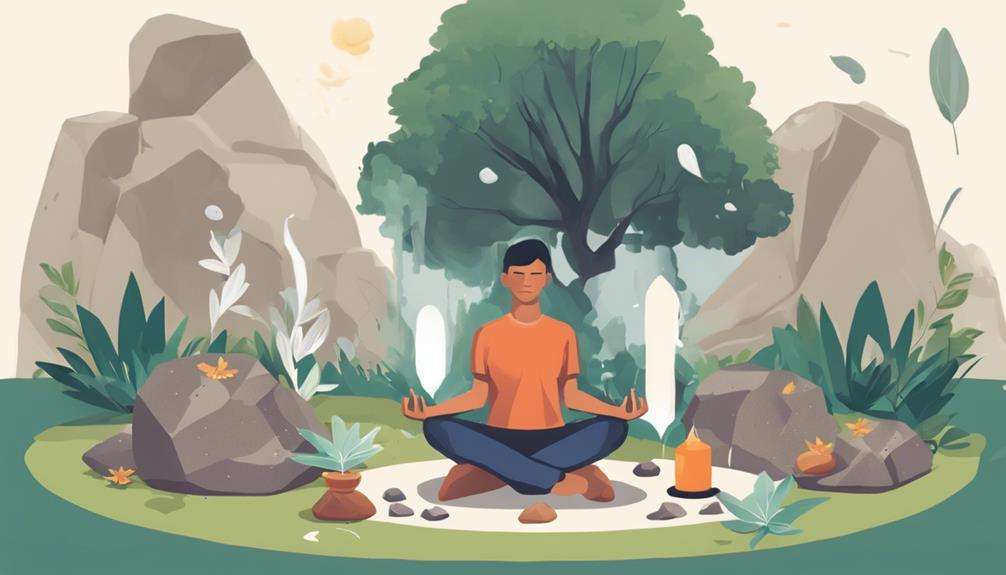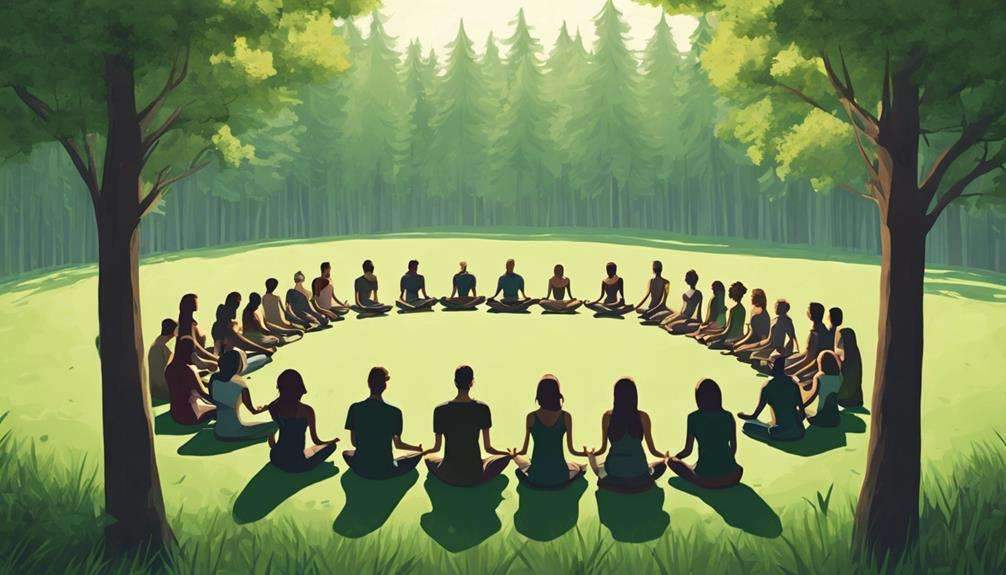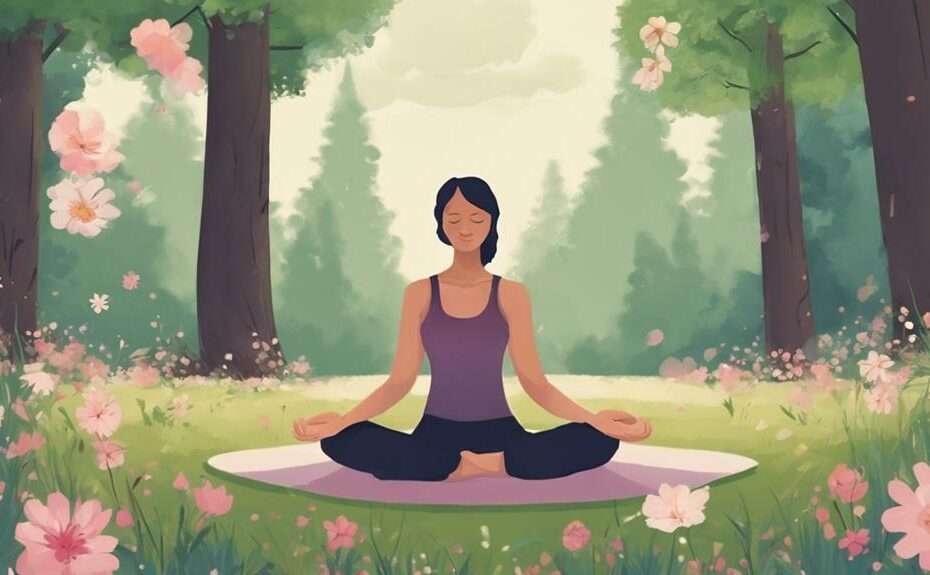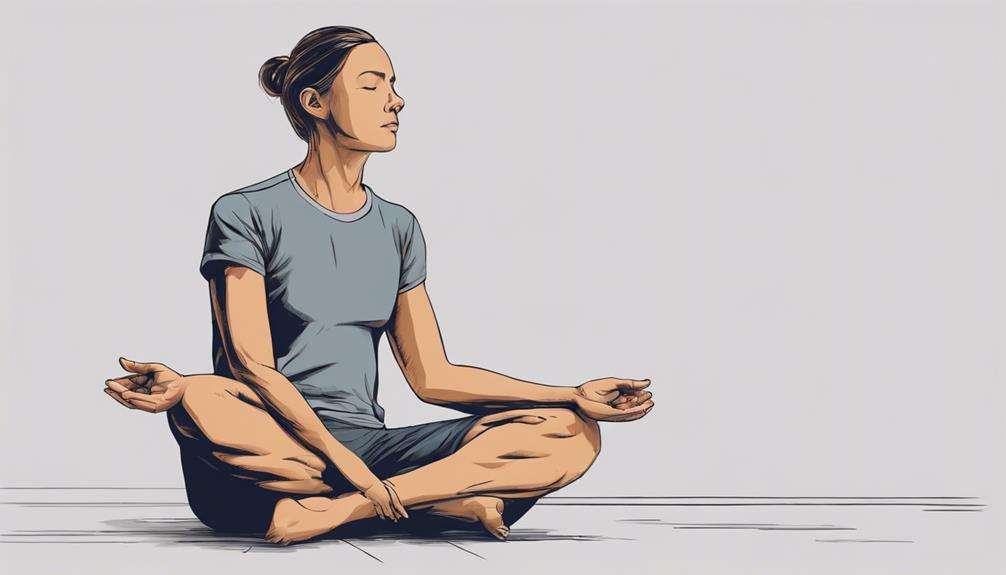As you commence on the journey of deep relaxation through meditation, imagine grounding exercises as the sturdy roots of a serene tree, anchoring you to the tranquility of the present moment.
These exercises serve as pillars of strength, guiding you towards a state of profound calmness.
Discover how these grounding techniques can not only bring peace to your mind but also foster a profound connection with yourself and the world around you, paving the way for a deeper exploration of inner stillness and clarity.
Key Takeaways
- Establish a bridge between body and Earth for deep relaxation.
- Cultivate inner peace and stability through grounding in meditation.
- Improve emotional regulation and mindfulness with grounding exercises.
- Enhance connection to self and surroundings for enhanced well-being.
Understanding Grounding in Meditation
Grounding in meditation serves as an essential link between your body's frequencies and the Earth's energies, fostering a sense of connection and balance vital for deep relaxation. When you engage in grounding techniques during meditation, you create a bridge between your inner self and the external world, allowing stress and anxiety to dissipate. These practices enable you to anchor yourself in the present moment, enhancing your connection with the Earth and promoting a profound sense of calm.
Through grounding exercises, you can center your thoughts and emotions, finding peace amidst chaos. By tapping into the Earth's energy, you establish a harmonious relationship with your surroundings, promoting a state of tranquility. These techniques are particularly beneficial for individuals facing high-stress situations, offering a sanctuary where you can retreat and find solace. Embracing grounding in meditation not only deepens your practice but also nurtures a strong sense of connection with yourself and the world around you.
Common Challenges in Mindfulness Practice
When engaging in mindfulness practice, you may encounter various challenges that hinder your ability to stay present and focused. It's crucial to feel like your attention is constantly being pulled by wandering thoughts, making it challenging to maintain your focus. This can lead to feelings of restlessness and difficulty in grounding yourself in the present moment.
Additionally, anxiety and stress reduction through mindfulness meditation can be obstructed by physical discomfort, distractions, and time constraints.
Managing these obstacles involves developing effective grounding techniques to anchor your attention. By acknowledging and accepting these challenges without judgment, you can better navigate through them. It's vital to cultivate patience with yourself and be kind in your approach to overcoming resistance. Establishing a regular mindfulness practice routine can also help in gradually improving your ability to stay present and focused. Remember, each hurdle you overcome brings you closer to a state of deep relaxation and inner peace.
Essential Techniques for Grounding

As you explore the essential techniques for grounding, you'll discover the profound benefits that come with this practice.
These techniques offer practical tips that can help you feel more centered and balanced during meditation.
Embracing grounding exercises can facilitate a deeper sense of relaxation and overall well-being.
Benefits of Grounding
Enhancing your sense of grounding can lead to a profound sense of inner peace and stability. By engaging in grounding techniques, you can effectively reduce stress levels, manage anxiety, and enhance emotional regulation. These practices help you feel more centered, connected, and balanced amidst life's challenges.
Grounding exercises also contribute to improving mindfulness, sharpening focus, and boosting overall well-being. Incorporating grounding meditation techniques that involve connecting with the Earth's energies can bring about deep relaxation and mental clarity.
Consistent practice of grounding not only supports your emotional well-being but also fosters a state of tranquility, peace, and profound relaxation within you. Embrace these benefits of grounding to nurture your inner calm and balance.
Practical Tips for Grounding
To ground yourself effectively and experience deep relaxation, start by incorporating practical tips that focus on connecting with the present moment and your surroundings. Grounding practices can help alleviate anxiety and promote mindfulness during meditation.
Begin by taking deep, intentional breaths to center your mind and body. Pay attention to the sensations in your body and the sounds around you, bringing your awareness to the present.
Engaging with external stimuli like touching a textured object or focusing on nature can also aid in grounding. Consistent practice of these techniques can greatly improve your ability to stay present, reduce stress, and enhance your overall well-being.
Embrace these grounding exercises as valuable tools for finding balance and calmness in your daily life.
Focus on Mindful Breathing
When you engage in mindful breathing, focus on the sensation of each breath entering and leaving your body to achieve deep relaxation. Pay attention to the rise and fall of your chest or the feeling of air passing through your nostrils.
This practice can help calm your mind, reduce stress, and bring you into the present moment. Mindful breathing isn't only a foundational aspect of meditation practices but also serves as a powerful tool to anchor your awareness during deep relaxation exercises.
Utilizing External Stimuli for Grounding

As you seek to deepen your relaxation practice, consider incorporating external stimuli like nature sounds or scents to enhance your grounding experience. Grounding techniques involving external stimuli, such as calming visuals or sensory experiences, can greatly elevate your meditation sessions.
By immersing yourself in natural elements like water sounds or earthy scents, you can foster a deeper sense of connection and peace. Experimenting with different external stimuli allows you to tailor your grounding practices to suit your preferences, promoting best relaxation and mindfulness.
Whether it's the gentle strumming of music or the soothing touch of soft fabrics, these additions can amplify the relaxation response. Embracing these sensory enhancements opens up a world of possibilities for creating a tranquil environment that supports your meditation journey.
The 5-4-3-2-1 Grounding Exercise
Take a moment to engage in the 5-4-3-2-1 grounding exercise.
By focusing on your senses, you can cultivate awareness and a stronger mind-body connection.
This practice is a powerful tool for centering yourself and promoting relaxation.
Sensory Awareness Practice
Engage all your senses in the present moment with the 5-4-3-2-1 grounding exercise for deep relaxation and mindfulness.
This sensory awareness practice is a powerful tool in reducing anxiety and fostering a sense of calm. By actively focusing on what you see, touch, hear, smell, and taste, you bring yourself into the present moment, away from worries and stress.
The 5-4-3-2-1 grounding exercise serves as a grounding practice, anchoring you in the now and promoting mindfulness. Embracing this exercise allows you to immerse yourself in the richness of your immediate surroundings, encouraging a deep connection with the present moment.
Take a moment to engage fully with your senses and experience the peace that comes with heightened sensory awareness.
Mind-Body Connection Exercise
Immerse yourself in the present moment by connecting your mind and body through the 5-4-3-2-1 Grounding Exercise for a profound sense of relaxation and mindfulness. Engage in this exercise to ground yourself and calm your mind when anxiety creeps in. Let's explore how this practice can help you:
- Ground: The 5-4-3-2-1 exercise grounds you in the present moment.
- Calm: It aids in calming your mind during moments of stress or anxiety.
- Mindfulness: By focusing on sensory experiences, it promotes mindfulness.
- Sensory Experiences: Engage with your senses to shift your focus.
- Relaxation: Experience relaxation as you redirect your attention to the here and now.
Practice this exercise whenever you need to reground yourself and find peace amidst daily challenges.
Enhancing Relaxation Through Group Exercises

To enhance your relaxation experience, consider participating in group grounding exercises that promote a collective sense of calm and focus. Engaging in group exercises allows you to make contact with a supportive community while deepening your relaxation through shared experiences. By keeping your eyes open during these group grounding techniques, you can feel a connection with others around you, fostering a sense of unity and tranquility.
Being part of a group activity amplifies the benefits of deep relaxation, as the shared energy and focus enhance your own grounding and centering. Collaborating in these group exercises not only amplifies the relaxation effects of meditation practices but also creates a space where everyone can feel more at ease, grounded, and connected with each other.
Incorporating group grounding exercises into your relaxation routine can lead to a profound sense of calm and well-being. The collective nature of these activities fosters a supportive environment that can deepen your relaxation experience and promote a stronger sense of community.
Integrating Grounding With Meditation Practices
Integrating grounding techniques with meditation practices consistently enhances relaxation and deepens your meditative experience. When you combine these two powerful tools, you open the door to a world of inner peace and emotional well-being.
Here are some ways in which integrating grounding with meditation can benefit you:
- Grounding techniques can help alleviate anxiety and stress during meditation sessions.
- By incorporating grounding exercises, you can enhance relaxation and create a sense of calmness in your mind and body.
- Grounding before meditation can assist in centering yourself, reducing distractions, and improving focus on the present moment.
- The combination of grounding and meditation techniques can promote emotional well-being and a sense of balance in your life.
- Practicing grounding alongside meditation can cultivate stability, tranquility, and a deeper connection to yourself and your surroundings.
Embrace the synergy of grounding and meditation to nurture a profound sense of peace and serenity within you.
Frequently Asked Questions
What Is the Rule of 5 Grounding Techniques?
To understand the Rule of 5 grounding technique, focus on engaging senses like sight, touch, hearing, smell, and taste. This practice helps you feel centered and calm by redirecting attention to your present surroundings.
What Is the Difference Between Grounding and Relaxation Techniques?
When differentiating between grounding and relaxation techniques, remember that grounding focuses on physical sensations and mental focus, while relaxation aims to release tension and connect mind and body. Both practices help you find calm and balance.
How Do You Ground Yourself After Meditation?
To ground yourself after meditation, focus on your breath and the support beneath you. Slowly reorient by moving gently. Feel nature's connection through walking or touching natural elements. Align your energy, heighten awareness, and stabilize emotions.
What Are the Grounding Techniques in Dbt?
To ground yourself in DBT, practice mindful breathing, sensory awareness, body scans, visualization exercises, progressive muscle relaxation, and guided imagery. These techniques help you manage emotions, stay present, and cultivate a sense of calm.
Conclusion
As you wrap up your grounding exercises for deep relaxation, remember that finding your center is like finding a needle in a haystack – it may take time and patience, but the rewards are worth it.
Keep practicing these techniques to cultivate inner peace and mindfulness in your daily life. Embrace the present moment with open arms, and let the grounding sensations guide you towards a state of tranquility and well-being.
You've got this!






